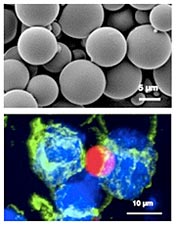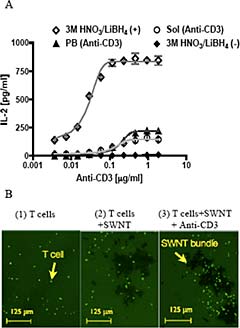A biomimetic approach to antigen-presentation using biodegradable polymers
Dendritic cells, which are professional antigen-presenting cells, interface with T cells via a complex set of interactions which culminate in T cell activation against the specific antigens being presented. Our program has developed a modular biodegradable particle platform that presents some of these important signals to T cells . These mimic the natural ability of dendritic cells in stimulating T cells but in addition are modular in nature allowing easy addition and subtraction of signals needed for efficient T cell stimulation while offering the flexibility over targeting different types of T cells enabling their expansion for a variety of disease states.
|
Stimulating the immune response against cancer is a goal of immunotherapy. That goal can be achieved by engineering the proper immune signals in an artificial, biodegradable, safe system that can be used inside or outside the body for expansion of cancer-fighting T cells. |
Top: Scanning electron microscope image of particles. Bottom: Particles (dyed red), interact with multiple T cells (blue/green. |
References
Steenblock E, Fahmy TM, A comprehensive platform for T cell stimulation based on biodegradable artificial antigen‐presenting cell microparticles. Molecular Therapy. 2008 Apr;16(4):765‐72.
Fadel TR, Steenblock ER, Stern E, Li N, Wang X, Haller G, Pfefferle L, Fahmy TM, Enhanced cellular activation with single-wall carbon nanotubes presenting antibody stimuli. Nanoletters. 2008 Jul;8(7):2070-6.
Steenblock E, Fahmy TM, Antigen-presentation on artificial substrates for immunotherapy. Design opportunities and challenges . Expert Opinion on Biological Therapy (In Press).
Enhanced antigen-presentation using Carbon Nanotube bundles
Recognizing that artificial-antigen presentation requires not only the proper cellular signals from the antigen-presenting platforms but also the appropriate microenvironment, we explored the use of carbon nanotube bundles as a medium for ex vivo cellular stimulation. Antibody stimuli adsorbed onto SWNT bundles represent a novel paradigm for efficient activation of lymphocytes, useful for basic science applications and clinical immunotherapy.
|
SWNT bundles combined with antibodies that stimulate T cells facilitate efficient stimulation and localization of lymphocytes (blue). |
A) Introduction of defects (HN03/LIBH4 on SWNT) induce greater stimulation than untreated or mildly treated SWNT in the presence of antibodies. B) SWNT activation is specfic to bundles incubated with the antibody. |



